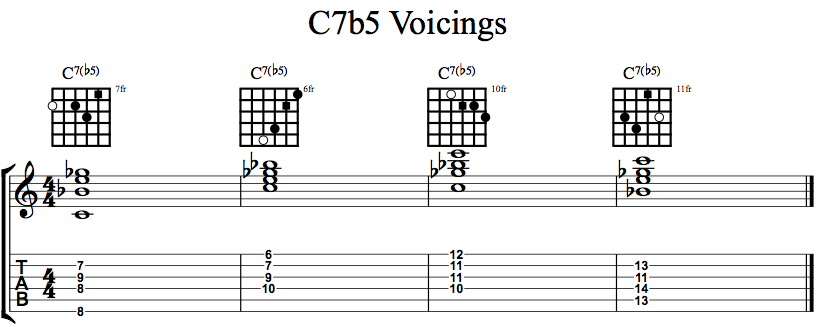A lot of the color in jazz comes from the sounds of the various altered dominant chords. How do altered dominant chords differ from normal dominant seventh chords? The essential chord tones (the root, 3rd, and 7th) remain the same but altered dominants have one or two different notes.
First things first, let’s define what is an altered dominant chord:
A dominant chord is considered altered if either of both the 5th or 9th are chromatically raised or lowered by one half step.
The 5th may be raised or lowered one half step (#5 or b5) and can be notated as C7#5 or C7b5, C7+5 or C7-5.
The 9th may be raised or lowered one half step (#9 or b9) and can be notated as C7#9 or C7b9, C7+9 or C7-9.
Both the 5th and the 9th may be raised or lowered one half step simultaneously and can be notated as C7#5#9, C7b5b9, C7b5#9, etc.
The root, 3rd, and 7th are not changed.
Let’s look at some altered dominant chord voicings.
C7b5: The dominant b5 chord contains the 1-3-b5-b7. For example, C7b5 contains C-E-Gb-Bb. Below are four C7b5 voicings:
C7#5: The dominant #5 chord contains the 1-3-#5-b7. For example, C7#5 contains C-E-G#-Bb. Below are four C7#5 voicings:
C7b9: The dominant b9 chord contains the 1-3-5-b7-b9. For example, C7b9 contains C-E-G-Bb-Db. Below are four C7b9 voicings:
C7#9: The dominant #9 chord contains the 1-3-5-b7-#9. For example, C7#9 contains C-E-G-Bb-D#. Below are four C7#9 voicings:
That’s a wrap on altered dominant chords. You can practice these voicings by picking a jazz standard and replacing the boring old dominant seventh chords with one of the fancy new altered dominant chords you just learned. This lesson just scratches the surface of all the altered dominant voicings available. See if you can create your own voicings! Start by taking a dominant sevent chord and adding a b5 and a b9. Then try it with a b5 and #9. And so forth!



